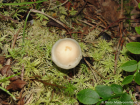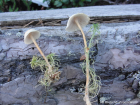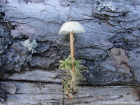Cap convex, and russet to ochre. Gills only thinly attached to the stem, whitish and crowded. Stem more or less similarly coloured as the cap, more or less equal but slightly bulbous at the base. The stem has no ring. Spore print white.
Microscopic Features: Spores are smooth, ellipsoidal, measuring 5-6.5μm in length and 2.5-3.5μm in width. They are inamyloid.
Synonyms: The mushroom is now known under the name Gymnopus dryophilus.
Gymnopus dryophilus (Collybia dryophila) on the www.first-nature.com web site.
Gymnopus dryophilus (Collybia dryophila) on the MushroomExpert.Com web site.
Many mushrooms are poisonous and some are lethally poisonous. It can be very difficult to distinguish between an edible and a poisonous mushroom. Because of that, we strongly advise against consuming wild mushrooms, and this site does not contain any information about the edibility or toxicity of mushrooms.
Although efforts have been made to ensure accuracy on this website, the information may contain errors and omissions. Therefore, the information presented here is for informational purposes only and should not be relied upon as any basis for consuming any plants or mushrooms.
Links to external websites that provide information about mushrooms are included for reference purposes only. We do not endorse, or assume responsibility for the information, content, or recommendations provided on these external sites.



